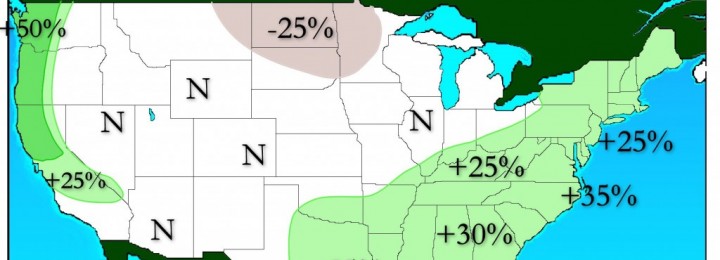Climate outlooks
-

In the past few weeks there have been many forecasts for the coming winter made online. Most are from bloggers with limited meteorological or climatological training, and should be taken with a large grain of salt. Others, from places like the Farmers’ Almanac, are mysteriously produced and vaguely worded so that they can claim they…
-

There has been a tremendous amount of hype the last few days about the coming cold outbreak that will be affecting most of the eastern 2/3 of the United States. Some bloggers and pundits have talked about “bombogenesis” and the return of the “polar vortex” and unprecedented cold temperatures. Dr. Michio Kaku, the so-called “science…
-

The 7-day QPF map shows another dry week in store for most of the Southeast. The only exception will be the peninsula of Florida, which will see a lot of rain along the boundary of the unusually cold air that is expected to move into the area during the week. I’ve discussed this outbreak of…
Posted in: Climate outlooks -

The first few days of November have been more than nine degrees below average for most of the Southeast. You can visualize this data for yourself (sample current map shown below) at the High Plains Climate Center’s current climate summary maps website: https://www.hprcc.unl.edu/maps/current/index.php?action=update_region®ion=US Unfortunately for those who like warm weather, these cold conditions are expected to…
-

An article yesterday in The Week shows that bad weather is good for incumbents on Election Day. This may be due to the strong desire of invested citizens to participate in governmental choice compared to what you might call “fair weather” voters who are more likely to be discouraged from voting if the weather is…
-

The state was split into “haves” and “have nots” in October as precipitation was plentiful in western Georgia but sorely lacking in the east. Temperatures across the state were generally above normal and many record highs were broken or tied. In Atlanta, the monthly average temperature was 66.2 degrees F (2.9 degrees above normal), in…
-

Last night parts of the Southeast experienced their first snowfalls of the year. A few areas in Georgia received over an inch, such as Fannin County, and many people sent in photos to the National Weather Service showing the snow that fell at their locations. Some areas in South Carolina received over 6 inches of…